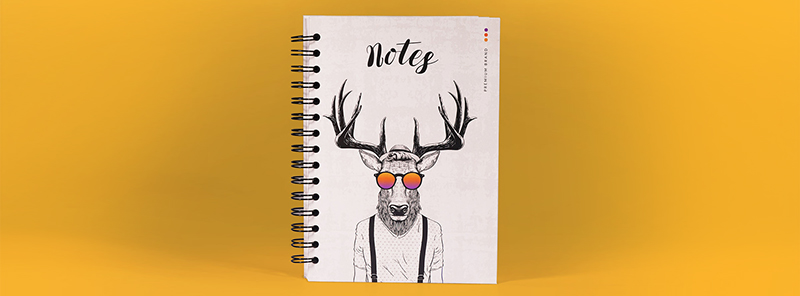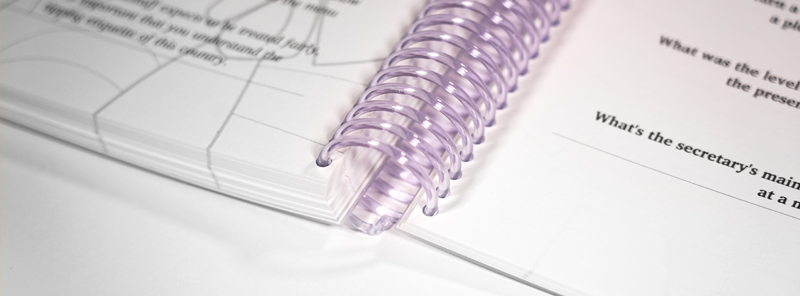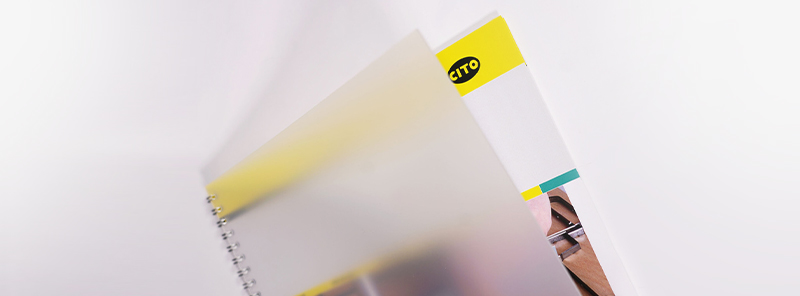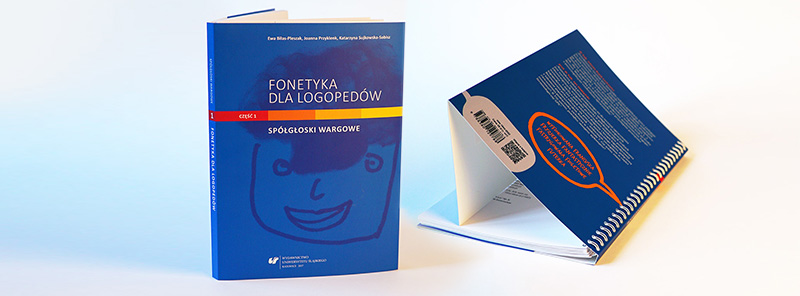
Spiral binding – the special binding
Associated mainly with calendars, regarded to be something akin to the ugly sister of traditional types of binding, in theory the simplest one to make — spiral binding is famous for all the wrong reasons. However, we are very fond of it and — judging by the number and variety of publications for which we use spiral binding — we are not an exception.
What is spiral binding?
In simplest terms, it is a type of binding where (as a rule, but there certainly are exceptions to it) the cover consists of back and front boards and is attached to the block by means of a spiral. As opposed to thread sewn or perfect bound blocks, the sheets that make up the block in spiral binding are not joined together.
Thus the biggest challenge in designing a publication will be allowing sufficient space for your perforation. The thicker the block, the larger the spiral needed, and consequently we will have to create a wider margin for the holes.
Let’s focus our attention on the spiral itself for a moment. If the material from which spirals are made is to be the criterion according to which we categorize them, then we distinguish metal Wire-O binding and PVC coils. The Wire-O binding is made of steel wire. If we are not happy with the natural colour of the wire, we can coat it with nylon plastic. The Wire-O binding is also referred to as “zip wire”, i.e. the loops are pushed together in such a way as to trap them in the perforations.

The second type of a spiral — which is made of PVC — resembles in its appearance a coil which is “threaded” into the perforations. Its main features are extraordinary durability and resistance to damage.
The good news is that the orientation of our publication is of no consequence here and spiral binding can be applied both along the shorter and the longer edge.

“The Tragedy of Hamlet, Prince of Denmark” in spiral binding then?
Spiral binding is not the noblest type of binding. Literature (and not only belles-lettres) in spiral binding is a bad idea — firstly for purely aesthetic reasons, and secondly the absence of a spine on which you can put the title and the author of the book would effectively prevent us from finding the desired item on the bookstore’s shelves. However, not all publications are designed to adorn our bookshelves. There are also those intended for special purposes for which we reach much more frequently and where style and sophistication take a back seat. So, what is important here? Functionality. Which is where spiral binding has no competitors.
If literature is out of the question, what exactly can we use spiral binding for then?
Publications of a more practical nature — everything to be to scribbled in and for taking notes (e.g. planners, diaries, notebooks, scratchpads). Spiral binding is also a good idea for products that are to be handled by numerous readers (e.g. price lists, menus, catalogues) and those that we will use outside the home, e.g. travel guides and atlases.
As far as current trends are concerned, the stage belongs to planners tailored to the needs of specific audiences such as photographers, teachers and mothers-to-be. Wedding planners attract particular interest. Publishers are well aware of the multitude of things and jobs to be done in advance of an event as big as a wedding, and they are getting more and more competitive in providing increasingly fancy features. There are now 3-year planners available, as opposed to those covering a mere one year of preparations for the big day.
Spiral binding has its fans also among enthusiasts of the boho-chic style that has recently become so popular, who do not hesitate to use it for wedding guest books and photo albums. The range of possible applications for spiral binding is therefore extremely wide.
What is the biggest and irrefutable advantage of spiral binding?
Full openability — and when saying “full” we mean nothing less than the full 360 degrees. The solution is particularly convenient when we want to take notes and do not have a desk or a table handy: we can open the book and comfortably write “in the air” on any page without having to break the spine.
In addition, durability! If we want to create an indestructible product, all we have to do is combine hard covers with a PVC coil. Let’s add to this some refinements in the form of glossy foil lamination and we can rest assured that our publication — despite being used intensively — will survive long years in an intact condition.
It is not only the hardcover binding that will protect our publications. If we want to increase the strength of softcover binding, we can add an additional cover, e.g. made of the transparent polypropylene EPLAK material, which is simply a clear plastic film. It is flexible and lightweight, while at the same time it will perfectly protect our cover against mechanical damage and the damp.

Spiral binding with a spine? It’s doable!
For those not entirely convinced as to the merits of spiral binding, there is one more option: enclosed spiral binding (also referred to as “closed”). Its design differs somewhat from the traditional spiral binding as the cover to a degree resembles that used in softcover binding — there is only one sheet of high grammage paper in place of two separate boards. So how is the cover attached to the insert/inside? The perforations are on the third (and inevitably the fourth) page of the cover. Thus we acquire a spine, and when the cover is closed the coil is visible only on its fourth page.

Spiral binding is not as black as it is painted
As you can see the range of applications of spiral binding is extremely wide, and it is increasingly often associated with durability, modernity and comfort, as opposed to something of an “inferior” quality. If we combine it with an attractive and well-thought-out design, the satisfaction of end recipients is guaranteed, which in the end is what it is all about.